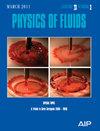基于特征的一对并排气缸准周期唤醒动力学流形建模
IF 4.1
2区 工程技术
Q1 MECHANICS
引用次数: 0
摘要
我们提出了一种基于特征的流形建模(FeMM)框架,用于研究一对并排圆柱体的准周期唤醒动力学。其关键驱动因素是根据提取的特征(如力系数以及来自实验和数值模拟的探测数据)嵌入最合理的均方场流形。然后,在模型结构的均方场约束条件下识别流形模型,确保人类的可解释性。FeMM 方法以穿越一对并排圆柱体的二维不可压缩流为例进行了演示,展示了准周期行为中的翻转唤醒。瞬态和瞬态后的动力学特征是与涡流脱落和间隙流振荡相关的两个耦合振荡器。动态模态分解分析揭示了这两种流动机制之间显著的模态相互作用,对基于投影的建模方法(如伽勒金投影法)提出了严峻的挑战。然而,基于力测量的 FeMM 方法产生了一个可解释的模型,解释了类周期动力学的基本机制,证明了它适用于具有多尺度和不变量集的高阶动力学。这种方法有望广泛应用于各种现实世界场景中的动态建模和状态估计。本文章由计算机程序翻译,如有差异,请以英文原文为准。
Feature-based manifold modeling for the quasiperiodic wake dynamics of a pair of side-by-side cylinders
We propose a feature-based manifold modeling (FeMM) framework for the quasiperiodic wake dynamics of a pair of side-by-side cylinders. The key enabler is to embed the most parsimonious mean-field manifold based on the extracted features, such as force coefficients and probing data from experiments and numerical simulations. The manifold model is then identified under the mean-field constraints of the model structure, ensuring human-interpretability. The FeMM method is demonstrated with a two-dimensional incompressible flow crossing a pair of side-by-side cylinders, exhibiting a flip-flopping wake in quasiperiodic behavior. The transient and post-transient dynamics are characterized by two coupled oscillators associated with vortex shedding and gap flow oscillations. Dynamic mode decomposition analysis reveals significant modal interactions between these two flow mechanisms, posing a serious challenge to projection-based modeling approaches, such as the Galerkin projection method. Nevertheless, the FeMM approach, based on force measurements, yields an interpretable model that accounts for the mechanisms underlying the quasiperiodic dynamics, demonstrating its applicability to higher-order dynamics with multiple scales and invariant sets. This approach is expected to have broad applicability in dynamic modeling and state estimation in various real-world scenarios.
求助全文
通过发布文献求助,成功后即可免费获取论文全文。
去求助
来源期刊

Physics of Fluids
物理-力学
CiteScore
6.50
自引率
41.30%
发文量
2063
审稿时长
2.6 months
期刊介绍:
Physics of Fluids (PoF) is a preeminent journal devoted to publishing original theoretical, computational, and experimental contributions to the understanding of the dynamics of gases, liquids, and complex or multiphase fluids. Topics published in PoF are diverse and reflect the most important subjects in fluid dynamics, including, but not limited to:
-Acoustics
-Aerospace and aeronautical flow
-Astrophysical flow
-Biofluid mechanics
-Cavitation and cavitating flows
-Combustion flows
-Complex fluids
-Compressible flow
-Computational fluid dynamics
-Contact lines
-Continuum mechanics
-Convection
-Cryogenic flow
-Droplets
-Electrical and magnetic effects in fluid flow
-Foam, bubble, and film mechanics
-Flow control
-Flow instability and transition
-Flow orientation and anisotropy
-Flows with other transport phenomena
-Flows with complex boundary conditions
-Flow visualization
-Fluid mechanics
-Fluid physical properties
-Fluid–structure interactions
-Free surface flows
-Geophysical flow
-Interfacial flow
-Knudsen flow
-Laminar flow
-Liquid crystals
-Mathematics of fluids
-Micro- and nanofluid mechanics
-Mixing
-Molecular theory
-Nanofluidics
-Particulate, multiphase, and granular flow
-Processing flows
-Relativistic fluid mechanics
-Rotating flows
-Shock wave phenomena
-Soft matter
-Stratified flows
-Supercritical fluids
-Superfluidity
-Thermodynamics of flow systems
-Transonic flow
-Turbulent flow
-Viscous and non-Newtonian flow
-Viscoelasticity
-Vortex dynamics
-Waves
 求助内容:
求助内容: 应助结果提醒方式:
应助结果提醒方式:


